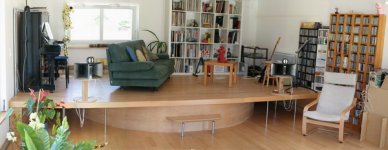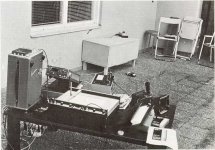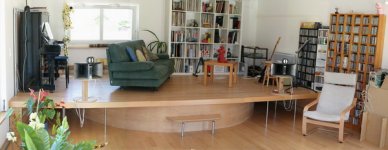Well,
Abandonming the idea of horn loaded stereo-speakers (the dimensions just became stupid), I'm lookinbg in to a "RT-Horn", a floor-standing horn presented in the old Swedish magasine "Radio & Television"
Since these artciles were published 30 years ago, none of the original 12" drivers are available any more, and even if they were, I'm sure some of the 30 years or so more recent stuff is actually a bit better.. (?)
From what I've managed to read up on, good horn drivers should have a fairly low Fs, at least lower than the horn cut-of, and a low Qts value (typ 0,2-0,3) . Low moving mass has also been mentioned as favorable.
it was therefore natural to look in to pro drivers, and one driver that has been mentioned as a candidate for these horns was The Eminence Kappa pro 12A
http://www.eminence.com/proaudio_sp...ink=KAPPAPRO-12A&speaker_size=12&SUB_CAT_ID=1
Then I came across a pioneer driver on partsxpress, which looked rather cheap and cheerfull, but some of the data caugt my attention.
http://www.partsexpress.com/pe/showdetl.cfm?&Partnumber=290-125
Fs of only 23Hz, well that sounds good!
Qts of 0.16, thats very low, hardly ever see figures like that actually..
The only "drawback" i can immediately identify with the Pioneer, is the limited Xmax of 2,5mm, but since I'm looking for a horn driver, that'mon't really be an issue.
Of course, the Pioneer will not stand up to 500-ish Watts of power, but that is not a problem either..
Could it be that this Pioneer driver is a perfect candidate for horn loading at a reasonable price, or am I completely off here?
Any advise would be much welcome!
Abandonming the idea of horn loaded stereo-speakers (the dimensions just became stupid), I'm lookinbg in to a "RT-Horn", a floor-standing horn presented in the old Swedish magasine "Radio & Television"
Since these artciles were published 30 years ago, none of the original 12" drivers are available any more, and even if they were, I'm sure some of the 30 years or so more recent stuff is actually a bit better.. (?)
From what I've managed to read up on, good horn drivers should have a fairly low Fs, at least lower than the horn cut-of, and a low Qts value (typ 0,2-0,3) . Low moving mass has also been mentioned as favorable.
it was therefore natural to look in to pro drivers, and one driver that has been mentioned as a candidate for these horns was The Eminence Kappa pro 12A
http://www.eminence.com/proaudio_sp...ink=KAPPAPRO-12A&speaker_size=12&SUB_CAT_ID=1
Then I came across a pioneer driver on partsxpress, which looked rather cheap and cheerfull, but some of the data caugt my attention.
http://www.partsexpress.com/pe/showdetl.cfm?&Partnumber=290-125
Fs of only 23Hz, well that sounds good!
Qts of 0.16, thats very low, hardly ever see figures like that actually..
The only "drawback" i can immediately identify with the Pioneer, is the limited Xmax of 2,5mm, but since I'm looking for a horn driver, that'mon't really be an issue.
Of course, the Pioneer will not stand up to 500-ish Watts of power, but that is not a problem either..
Could it be that this Pioneer driver is a perfect candidate for horn loading at a reasonable price, or am I completely off here?
Any advise would be much welcome!
What's it like?I'm looking in to a "RT-Horn", a floor-standing horn presented in the old Swedish magazine "Radio & Television"
Depends on the application, in larger high power bass horns a high moving mass would be (much) more suitable. A strong cone,. large VC, low Fs and large Xmax would all result in higher moving mass. In such case low mmd would only be suitable for (very) low level listening.Low moving mass has also been mentioned as favorable.
I have a (naturally developed) distrust against such low Qts specs on cheap (large-ish bass) drivers.Then I came across a pioneer driver on partsxpress, which looked rather cheap and cheerfull, but some of the data caugt my attention.
Apart from that I would rather pick the driver based upon the horn parameters than pick a driver on some rule of thumb guidelines and hope it to work in a specific design.
There are single enclosures ment for low frequency production that will work specifically with low Qts drivers but also that will work specifically with high Qts drivers.
Wkr Johan
Hello,
There is often a solution for bass horn that is still WAF.
In the attached picture you'll see the (Le Cléac'h) bass horn built by my friend Frédéric Lebas.
Best regards from Paris, France
Jean-Michel Le Cléac'h
There is often a solution for bass horn that is still WAF.
In the attached picture you'll see the (Le Cléac'h) bass horn built by my friend Frédéric Lebas.
Best regards from Paris, France
Jean-Michel Le Cléac'h
Elbert said:Well,
Abandonming the idea of horn loaded stereo-speakers (the dimensions just became stupid),
Attachments
What horn,
Well, that's a valid question to start with..
This is a front-loaded wall-horn where the body of the horn is actually standing on four legs, using the rear-wall and floor as part of the horn.
The theory is that the opening formed between the horn body and the floor acts as the horn mouth. Further to this, the horn is based around the theory that the relatively narrow horn mouth will have its effective area doubled by floor reflection.
This horn was originally designed and published by "radio & television" in 1973, known as the "RT-1" horn. This horn was designed for 10" woofers.
In 1978, the horn was re-launched in two new versions intended for 12" drivers; "RT-2" with approximately the same size and cut-off as the original RT-1 horn, and a slightly smaller horn, RT-3.
On the enclosed image, the smaller RT-3 horn can be seen.
It is the larger RT-2 I am most interested in.
The horn is cited as being capable of 30 HZ, and some measurements show a roll-off starting at around 45 Hz. These measurements were however taken at the horn mouth, thereby not giving the benefit of any room assistance.
Wether or not introducing a bass-horn in the form of a plateau in the living-room is wife-friendly, may of course be subject to debate, but what i like about the RT-horns is that they are fairly large horns which lends them selves rather nicely towards blending in with furniture.
It would make for a great TV table provided the vibrations are not to severe.
So, the drivers...
Agree that hornresp would be a great tool for checking a driver for compatibility with this horn, or better still, adapt the horn to the driver.
But I must admit that I'm not quite sure how to reverse-engineer this horn design for the purpose of simulation.
Perhaps I would be better off designing an entirely new horn from scratch and then fold it in a similar fashion?
Regarding drivers, I agree that the Pioneer sounds to good (and inexpensive) to be true. it would be interresting to know if it's only the specs being far too optimisitc, or if there is just some hidden trade-off..
looks like we've got a good horn thread going here, could be interesting...
Well, that's a valid question to start with..
This is a front-loaded wall-horn where the body of the horn is actually standing on four legs, using the rear-wall and floor as part of the horn.
The theory is that the opening formed between the horn body and the floor acts as the horn mouth. Further to this, the horn is based around the theory that the relatively narrow horn mouth will have its effective area doubled by floor reflection.
This horn was originally designed and published by "radio & television" in 1973, known as the "RT-1" horn. This horn was designed for 10" woofers.
In 1978, the horn was re-launched in two new versions intended for 12" drivers; "RT-2" with approximately the same size and cut-off as the original RT-1 horn, and a slightly smaller horn, RT-3.
On the enclosed image, the smaller RT-3 horn can be seen.
It is the larger RT-2 I am most interested in.
The horn is cited as being capable of 30 HZ, and some measurements show a roll-off starting at around 45 Hz. These measurements were however taken at the horn mouth, thereby not giving the benefit of any room assistance.
Wether or not introducing a bass-horn in the form of a plateau in the living-room is wife-friendly, may of course be subject to debate, but what i like about the RT-horns is that they are fairly large horns which lends them selves rather nicely towards blending in with furniture.
It would make for a great TV table provided the vibrations are not to severe.
So, the drivers...
Agree that hornresp would be a great tool for checking a driver for compatibility with this horn, or better still, adapt the horn to the driver.
But I must admit that I'm not quite sure how to reverse-engineer this horn design for the purpose of simulation.
Perhaps I would be better off designing an entirely new horn from scratch and then fold it in a similar fashion?
Regarding drivers, I agree that the Pioneer sounds to good (and inexpensive) to be true. it would be interresting to know if it's only the specs being far too optimisitc, or if there is just some hidden trade-off..
looks like we've got a good horn thread going here, could be interesting...
Attachments
Hi Anders!
Thanks for pointing me to that thread!
As with a lot of other stuff from the old RT magazines, I found these articles very interesting!
Looking at the professional level in those magazines is quite amazing compared with a lot of the rubbish out in print today. Fed up with subjective nonsense reviews of cables and obscure exotica with astronomical prices justified by snake-oil quasi-science, I've just about quit buying magazines altogether!
The last decent magazine was the Danish "high-fidelity" before they too departed from enthusiast tweaks and DIY in favour of "high-end"...
What good fortune for me that my father has almost the complete 70's issues of RT!
Very interesting to hear that you have personal experience with these horns Anders...
would you say that the bass-reproduction of these horns stil have something going for them today, or have they become an anachronism in the face of new and improved direct radiator technology?
Having said that, perhaps some new drivers could add some serious improvement to the concept??
Thanks for pointing me to that thread!
As with a lot of other stuff from the old RT magazines, I found these articles very interesting!
Looking at the professional level in those magazines is quite amazing compared with a lot of the rubbish out in print today. Fed up with subjective nonsense reviews of cables and obscure exotica with astronomical prices justified by snake-oil quasi-science, I've just about quit buying magazines altogether!
The last decent magazine was the Danish "high-fidelity" before they too departed from enthusiast tweaks and DIY in favour of "high-end"...
What good fortune for me that my father has almost the complete 70's issues of RT!
Very interesting to hear that you have personal experience with these horns Anders...
would you say that the bass-reproduction of these horns stil have something going for them today, or have they become an anachronism in the face of new and improved direct radiator technology?
Having said that, perhaps some new drivers could add some serious improvement to the concept??
Re: Re: Bass horn driver?
Thanks Jean, thats a brilliant idea I would like use
Jmmlc said:Hello,
In the attached picture you'll see the (Le Cléac'h) bass horn built by my friend Frédéric Lebas.
Best regards from Paris, France
Jean-Michel Le Cléac'h
Thanks Jean, thats a brilliant idea I would like use
Attachments
Just a little bit of inspiration of the horn kind.
kind.  http://www.faktiskt.se/modules.php?name=News&file=article&sid=179
http://www.faktiskt.se/modules.php?name=News&file=article&sid=179
NOT my system.
NOT my system.
At least partly OT....I think this one has been linked before...
http://www.royaldevice.com/custom.htm#THE REAL TOTAL HORN
Well.... some like it BIG
http://www.royaldevice.com/custom.htm#THE REAL TOTAL HORN
Well.... some like it BIG
back to the problem..
Now, back to the challenge of modeling the RT-2 horn in Hornresp...
The throat area of the horn is pretty straight forward, it equals the diaphragm area..
Then there is the challenge of figuring out the mouth area.. I guess one could just take the physical dimensions of the opening as it apears between the body of the horn and the wall/floor.
however, the theory behind this design is based on the effective mouth-area being double that of the physical area due to reflection off the floor.
The approximative length can be taken by making measurements of the construction drawing...
But the big question is still; what is the exponential ratio used?? Since the original profile is approximated by straight sections, figuring out the original exponential profile will be tricky..
Heck.. this is going to be a bit difficult...
Now, back to the challenge of modeling the RT-2 horn in Hornresp...
The throat area of the horn is pretty straight forward, it equals the diaphragm area..
Then there is the challenge of figuring out the mouth area.. I guess one could just take the physical dimensions of the opening as it apears between the body of the horn and the wall/floor.
however, the theory behind this design is based on the effective mouth-area being double that of the physical area due to reflection off the floor.
The approximative length can be taken by making measurements of the construction drawing...
But the big question is still; what is the exponential ratio used?? Since the original profile is approximated by straight sections, figuring out the original exponential profile will be tricky..
Heck.. this is going to be a bit difficult...
GM, you are of course correct...
But it seems I'm making some headway here...
Based on my method of assumption described earlier on, I
modelled a horn with a throat area of 570 cm2, length of 216 cm, and mouth area of 6820 cm2 with an exponential contour.
Acording to Hornresp. that should give a flare cut-off of 30 Hz.
This is allso the stated cut-off frequency of the RT-2 horn!
I did the model with the pioneer driver, and the SPL curve is not too unfamiliar to those measured at the mouth of the original horn.
Now, here's the exiting bit... one of the drivers tested with the original horn was a JBL 2202. As opposed tho some of the other drivers that were used, this JBL should have some available parameters..
So next step is to dig these parameters up, plug in to horn resp and see if the curve resembles the one measured 30 years ago!
To be continued...
But it seems I'm making some headway here...
Based on my method of assumption described earlier on, I
modelled a horn with a throat area of 570 cm2, length of 216 cm, and mouth area of 6820 cm2 with an exponential contour.
Acording to Hornresp. that should give a flare cut-off of 30 Hz.
This is allso the stated cut-off frequency of the RT-2 horn!
I did the model with the pioneer driver, and the SPL curve is not too unfamiliar to those measured at the mouth of the original horn.
Now, here's the exiting bit... one of the drivers tested with the original horn was a JBL 2202. As opposed tho some of the other drivers that were used, this JBL should have some available parameters..
So next step is to dig these parameters up, plug in to horn resp and see if the curve resembles the one measured 30 years ago!
To be continued...
Well, the simulated JBL curve and the measured response from the magasine had some diferences, but nothing wild..
The measurement was actually a bit smoother and had slightly better low frequency extension.
But it looks close enough to at least partially validate the horn model in Hornresp.
Heck.. haven't quite figured out how to save or export the frequency response plot..
When i get my head round it, I'll see if I can post the calculated and measured curves here!
The measurement was actually a bit smoother and had slightly better low frequency extension.
But it looks close enough to at least partially validate the horn model in Hornresp.
Heck.. haven't quite figured out how to save or export the frequency response plot..
When i get my head round it, I'll see if I can post the calculated and measured curves here!
- Status
- This old topic is closed. If you want to reopen this topic, contact a moderator using the "Report Post" button.
- Home
- Loudspeakers
- Multi-Way
- Bass horn driver?



